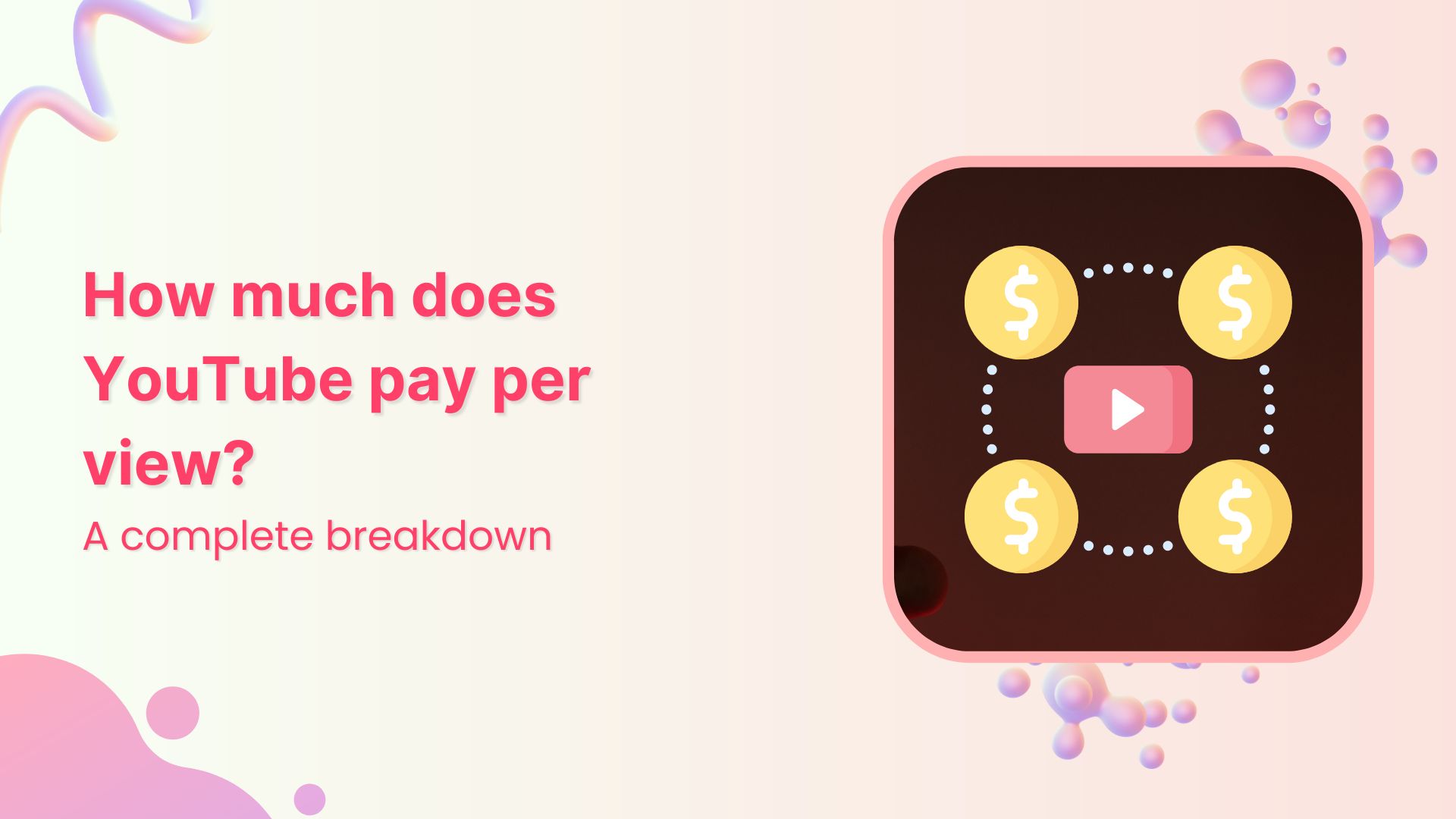AI video generation is now live - with all the premium models. Start creating
How much does YouTube pay per view: A complete breakdown

YouTube has become one of the most lucrative platforms for content creators, with millions of people worldwide turning their passion into profit. But one question that consistently comes up is: how much does YouTube pay per view?
The answer is not as straightforward as you might think, as it depends on numerous factors that can impact your earnings from YouTube.
In this detailed guide, we will break down everything you need to know about YouTube’s payment structure, from the factors that influence your earnings to practical tips for maximizing your revenue potential.
How much does YouTube pay per view on average?
YouTube does not pay creators any fixed amount per view. Instead, the platform operates on a revenue-sharing model where creators earn money through various monetization features, with ad revenue being the primary source.
The average YouTube creator earns between $0.01 to $0.03 per view, but this figure can vary dramatically based on several factors. Some creators earn as little as $0.003 per view, while others in high-paying niches can earn $0.05 or more per view.
How much does YouTube pay for 1 million views?
When people ask, “how much does YouTube pay for 1 million views?” they’re usually looking for a concrete number. Based on industry averages, creators typically earn between $1,000 to $3,000 for 1 million views.
However, this range can extend from as low as $500 to as high as $10,000, depending on the factors we’ll discuss later.
It’s important to note that YouTube doesn’t pay creators directly for views. Instead, they pay based on ad impressions and clicks. It means that even if your YouTube video gets 1 million views, you’ll only earn money from the portion of viewers who actually see and interact with ads.
YouTube earnings by niche (per million views)
Different content categories generate varying levels of revenue based on advertiser demand and audience value. Let’s have a closer look at the average cost per thousand impressions (CPM) of different niches to determine how much YouTube pays per view to different types of channels:
- Finance and investing content has the highest CPMs due to high-value financial service advertisements. Channels like Graham Stephan and Andrei Jikh typically earn $4,000-$10,000 per million views, benefiting from audiences with significant purchasing power and investment capital.

- Technology content attracts premium advertisers targeting tech-savvy consumers with disposable income. Popular tech channels like Marques Brownlee (MKBHD) and Unbox Therapy earn $3,000-$7,500 per million views due to their influence on purchasing decisions for expensive gadgets and software.
- Educational content performs exceptionally well. Channels like CrashCourse and Khan Academy are earning substantial revenue. Educational videos, including tutorials, online courses, and how-to content, typically generate $2,500-$6,000 per million views due to their high engagement rates and advertiser appeal.
- Health and fitness content attracts advertisers from the supplement, equipment, and wellness industries. Channels like Athlean-X and Calisthenic Movement earn $2,000-$6,000 per million views, particularly when targeting audiences interested in fitness products and health services.
- Gaming content has a massive audience reach but lower individual CPMs. Popular gaming channels like PewDiePie (one of the most subscribed YouTube channels) and Markiplier typically earn $1,000-$4,000 per million views, though they compensate with high view counts and diverse revenue streams, including sponsorships and merchandise.
- Beauty and fashion content benefits from cosmetics and fashion brand partnerships. Creators like James Charles and Jeffree Star earn $1,500-$5,000 per million views, with additional revenue from brand collaborations and product launches significantly boosting overall income.
- Lifestyle and vlogging content vary widely based on audience demographics and creator influence. Channels like Emma Chamberlain and David Dobrik earn $1,000-$3,500 per million views, with brand partnerships often exceeding ad revenue significantly.
- Entertainment and comedy content typically have the lowest CPMs but can achieve viral reach. Channels like MrBeast (the most followed YouTube channel) and Dude Perfect earn $500-$3,000 per million views from ads alone but generate substantial income through sponsorships and business ventures.
The following table summarizes the estimated revenue ranges across these major content categories:
| Niche | CPM Range | Estimated Earnings (1M Views) |
| Finance & Investing | $8-20 | $4,000-$10,000 |
| Technology | $6-15 | $3,000-$7,500 |
| Education | $5-12 | $2,500-$6,000 |
| Gaming | $2-8 | $1,000-$4,000 |
| Entertainment | $1-6 | $500-$3,000 |
| Beauty & Fashion | $3-10 | $1,500-$5,000 |
| Health & Fitness | $4-12 | $2,000-$6,000 |
| Lifestyle & Vlogging | $2-7 | $1,000-$3,500 |
Related: How to become a YouTuber & make money in 2025?
How does YouTube pay content creators?
YouTube’s monetization system is built around the YouTube Partner Program (YPP). It allows eligible creators to earn money from their content through various revenue streams.
YouTube partner program requirements
YouTubers have to meet the following criteria to join the YPP and start earning money:
- Have at least 1,000 subscribers
- Accumulate 4,000 watch hours in the past 12 months OR 10 million valid public Shorts views in the last 90 days
- Live in a country where the YPP is available
- Have no active Community Guidelines strikes
- Have 2-step verification enabled on their Google account
- Have an AdSense account linked to their YouTube channel
YouTube Shorts monetization
YouTube Shorts has introduced new monetization opportunities for creators. The YouTube Shorts monetization program allows creators to earn money from their short-form content through:
- Shorts fund: A $100 million fund distributed to eligible creators
- Shorts ad revenue: Creators can now earn from ads shown between Shorts videos
- Channel memberships: Viewers can support creators through monthly memberships
- Super Thanks: Viewers can purchase Super Thanks to show appreciation for the Shorts content
The payment structure for Shorts differs from regular YouTube videos, with creators typically earning less per view but potentially reaching larger audiences due to the viral nature of short-form content and doomscrolling by a lot of users.
Different ways of making money on YouTube
Successful YouTubers rarely rely on a single income stream. Here are the primary ways to monetize your YouTube presence:
- YouTube Partner Program (AdSense)
The foundation of YouTube monetization, AdSense, pays creators a share of advertising revenue. YouTube keeps 45% of ad revenue while creators receive 55%. However, this is typically the smallest portion of successful creators’ total income.
- Channel memberships
Channel memberships allow viewers to support creators through monthly subscriptions ranging from $0.99 to $499.99. However, such subscriptions are available in certain countries and regions.
Members receive exclusive perks like:
- Custom badges and emojis
- Members-only posts and content
- Special live stream access
- Early video access
Creators typically keep 70% of membership fees after YouTube’s 30% cut.
- Super Chat, Super Thanks, and Super Stickers
These features enable viewers to financially support creators during live streams and on regular videos:
- Super Chat: Highlighted messages during live streams ($1-500)
- Super Thanks: One-time tips on any video ($2-50)
- Super Stickers: Animated stickers during live streams ($1-50)
- YouTube merchandise sales
Selling merchandise related to your channels can be quite lucrative. You can sell physical products branded with creator logos, catchphrases, or designs. The amount of money you make via merchandise sales is mainly dependent on your channel size:
- Small channels (5,000 monthly views): $170-870/month
- Medium channels (50,000 monthly views): $730-3,500/month
- Large channels (1M+ monthly views): $4,000+ monthly
- Brand sponsorships and partnerships
Brand sponsorships and partnerships are typically the highest-earning revenue stream for established content creators on YouTube:
- Dedicated sponsorship videos: $1,000-100,000+ per video
- Product integrations: $500-50,000+ per mention
- Long-term brand ambassadorships: $5,000-500,000+ annually
- Campaign collaborations: $2,000-1,000,000+ per campaign
Sponsorship rates typically range from $10-$50 per 1,000 views, but can vary dramatically based on niche and audience demographics.
- Affiliate marketing
Affiliate marketing involves promoting products and earning commissions on sales:
- Commission rates: 1-50% per sale (depending on product/service)
- Average earnings: $75-9,000+ per month (highly variable)
- Best niches: Technology, finance, lifestyle, education
Related: 20 Best affiliate marketing programs for beginners in 2025
- Digital products and courses
Creating and selling your own educational content on YouTube can also help you generate a significant amount of money:
- Online courses: $50-5,000+ per course
- E-books and guides: $10-200 per product
- Coaching and consulting: $50-500+ per hour
- Software and tools: $10-200+ per month (subscription)
- Patreon and external memberships
Many creators supplement YouTube income with external subscription platforms:
- Average Patreon contribution: $7 per supporter
- Platform fees: 5-12%, depending on plan
- Monthly earnings: $100-50,000+ (varies widely by audience size)
- Live streaming donations
Real-time financial support during live broadcasts has become a major revenue stream for YouTube creators who regularly engage with their audience through live streaming. Platforms like Streamlabs, StreamElements, and YouTube’s own Super Chat feature enable viewers to make instant donations ranging from $1 to $500 or more during live broadcasts.
These donations often come with special visual effects, highlighted messages, or audio alerts that create an interactive experience for both the creator and their community.
Related read: How to go livestream on YouTube?
Factors affecting the amount of money per view from YouTube
Several key factors determine how much money you can earn per view on YouTube:
- Niche and content category
Your content niche significantly impacts your earning potential. Finance, technology, and business content typically command higher CPMs (cost per thousand impressions) as discussed before because advertisers in these sectors have larger budgets and are willing to pay more to reach their target audience.
- Ad demand and seasonality
Ad demand fluctuates throughout the year, with higher demand (and higher CPMs) typically occurring during:
- Q4 (October-December) due to holiday shopping
- Back-to-school season (August-September)
- Major shopping events like Black Friday and Cyber Monday
Related: What is native advertising?
- Types of ads
Different ad formats generate varying revenue:
- Skippable video ads: Lower CPM but higher volume
- Non-skippable ads: Higher CPM but may affect viewer experience
- Display ads: Lower revenue, but don’t interrupt video viewing
- Overlay ads: Minimal revenue impact
Bonus tip: Videos over 8 minutes can include mid-roll ads, significantly increasing earning potential. Many successful creators strategically create content longer than 10 minutes to maximize ad placements. However, longer videos must maintain viewer engagement as forcing length without substance will hurt retention rates.
- Target audience location
Viewers’ geographic location significantly affects earnings. Traffic from countries with strong economies typically generates higher revenue:
- Tier 1 countries (US, UK, Canada, Australia): $2-15 CPM
- Tier 2 countries (European nations, Japan): $1-5 CPM
- Tier 3 countries (Developing nations): $0.10-2 CPM
Related: Effective tips to get better at audience segmentation
- Ad blockers and demonetization
Ad blockers can significantly reduce your revenue, as creators don’t earn money from viewers using ad-blocking software. Moreover, videos that violate YouTube’s policies may be demonetized, cutting off ad revenue entirely.
How much money can you make on YouTube?
Now that we hav discussed the average YouTube pay per view and also different sources of generating money, let’s take a closer look at the earning potential.
Keep in mind that the amount of money you can make on YouTube varies dramatically based on your niche, audience size, and monetization strategy. Understanding realistic expectations at different growth stages can help you plan your YouTube journey effectively.
| Channel size | Subscribers | Monthly earnings | Primary revenue sources |
| Small channels | 1,000-10,000 | $10-500 | AdSense, affiliate marketing |
| Medium channels | 10,000-100,000 | $500-5,000 | AdSense, sponsorships, memberships |
| Large channels | 100,000-1M | $3,000-50,000 | Brand deals, merchandise, and diverse streams |
| Mega channels | 1M+ | $10,000-500,000+ | Major partnerships, business ventures |
Let’s explore each growth stage in detail to understand what you can realistically expect at different levels of your YouTube journey.
Small channels (1,000-10,000 subscribers)
Creators in this range typically earn $10-500 per month from AdSense alone. However, many supplement their income through other streams:
- Ad Revenue: $50-300 per month
- Affiliate Marketing: $100-800 per month (depending on niche)
- Sponsored Content: $200-1,500 per video (for channels with high engagement)
Real creators in this bracket report varying experiences. Automotive channels with 4,000-12,000 subscribers often earn $640-900 monthly, while gaming channels with similar subscriber counts can earn $500-725 monthly from a mix of ad revenue and sponsorships.
Channels like smaller tech reviewers or niche hobby creators often fall into this category, where consistent content creation and community engagement are more important than viral reach.
Medium channels (10,000-100,000 subscribers)
This growth stage offers significantly more earning potential:
- Ad Revenue: $500-3,000 per month
- Brand Sponsorships: $1,000-5,000 per sponsored video
- Merchandise Sales: $200-2,000 per month
- Channel Memberships: $100-1,000 per month
YouTubers with 100,000 subscribers typically earn $5,000-15,000 monthly from all revenue sources combined. However, creators in high-value niches like finance or technology often exceed these averages significantly.
Educational channels like smaller science educators or lifestyle creators like mid-tier fitness instructors typically operate at this level, where brand partnerships become more frequent and merchandise sales gain traction.
Large channels (100,000-1,000,000 subscribers)
At this level, YouTube becomes a substantial income source:
- Ad Revenue: $3,000-15,000 per month
- Brand Deals: $5,000-50,000 per sponsored video
- Merchandise: $2,000-10,000 per month
- Other Revenue Streams: $1,000-20,000 per month
Many creators in this range report monthly earnings between $10,000-50,000, with some high-performing channels in lucrative niches earning six figures monthly.
Established creators like mid-tier gaming personalities, popular cooking channels, or successful business advice creators often reach this subscriber range, where multiple revenue streams become essential for maximizing income potential.
Mega channels (1,000,000+ subscribers)
Top-tier YouTubers operate like media companies:
- Ad Revenue: $10,000-100,000+ per month
- Brand Partnerships: $50,000-500,000+ per deal
- Business Ventures: Often their largest income source
- Merchandise & Products: $20,000-200,000+ per month
The highest-earning YouTubers like MrBeast reportedly earn $3-5 million monthly through diverse revenue streams, including their own business ventures and massive brand partnerships.
Geographic impact on earnings
Remember that your target audience location significantly affects earnings potential. Creators with primarily US, Canadian, or UK audiences earn substantially more than those with audiences from developing countries.
Some creators report earning only $3 daily from 5,000 views when their audience is primarily from countries with lower ad spending power.
Remember, these figures represent total earnings from all revenue sources, not just ad revenue. Successful YouTubers often earn more from sponsorships, merchandise, and other ventures than from YouTube’s ad revenue alone.
Bonus tips: How to get more views and make more money on YouTube?
Here are some tried-and-tested tips you can follow to get more views and make more money on YouTube:
- Create compelling content that hooks viewers
Your content’s first impression determines everything. Invest in creating eye-catching thumbnails with high-contrast colors, clear text, and emotional expressions that stand out in YouTube’s crowded interface.
The first 15 seconds of your video are equally crucial—start with a compelling hook that immediately addresses your video’s main promise, provide a quick preview of what’s coming, and deliver value right away rather than lengthy introductions.
Research relevant keywords using tools like the YouTube keyword generator and naturally incorporate them into your titles, descriptions, and tags for search optimization. Write detailed descriptions of 200+ words that provide context, use relevant hashtags to improve discoverability, and create compelling end screens that guide viewers to more of your content.
- Streamline your workflow with professional tools
Using a comprehensive social media management platform like ContentStudio can dramatically transform your YouTube strategy and overall online presence. The platform offers an all-in-one solution that addresses every aspect of content creation, scheduling, and optimization.
Here are some key benefits of using ContentStudio to manage your YouTube presence:
- Schedule videos: Plan and schedule YouTube videos for optimal posting times when your audience is most active, ensuring maximum visibility and engagement
- Content calendar management: Organize your content calendar weeks or months in advance, maintaining consistency and allowing for strategic content planning
- Cross-platform coordination: Coordinate YouTube releases with promotional posts across Facebook, Instagram, X (Twitter), and LinkedIn to maximize reach and build anticipation
- Custom thumbnail design: Create eye-catching thumbnails directly within ContentStudio’s interface using professional templates specifically optimized for YouTube’s requirements and best practices
- AI-powered writing assistance: Use the AI writing assistant to generate compelling video titles that drive clicks, write engaging descriptions optimized for search, and create attention-grabbing social media posts to promote your videos
- Unified analytics dashboard: Monitor your YouTube analytics alongside other social media metrics from one centralized location, making it easier to identify patterns and opportunities
- Team collaboration: Enable team members to collaborate on content creation, review, and approval processes through ContentStudio’s approval workflow features
- Content repurposing: Easily repurpose your YouTube content for other platforms with platform-specific formatting and optimization
The platform’s comprehensive approach eliminates the need for multiple tools, saving both time and money while providing professional-grade features that can significantly accelerate your YouTube growth and monetization potential.
Here’s a comprehensive tutorial of how you can use ContentStudio to schedule and post your YouTube videos:
- Build engaged communities and optimize monetization
Focus on audience retention by using the “hook, story, payoff” framework and including pattern interrupts every 30-60 seconds to maintain attention.
Engage meaningfully with your community by responding to comments promptly, asking questions in your videos, and creating community posts between uploads to maintain engagement.
Strategic monetization requires diversifying revenue streams early rather than waiting until you’re “big enough.” Start building email lists and social media followings immediately, create valuable content that positions you as an authority, and develop relationships with brands and fellow creators.
Long-term success strategies:
- Create evergreen content that continues generating views over time
- Develop series and playlists that encourage binge-watching
- Build content upgrades and lead magnets to capture email subscribers
- Plan content that can be repurposed across multiple platforms and formats
Related: 15 actionable tips to get free YouTube subscribers
Conclusion
Understanding how much YouTube pays per view requires recognizing that there’s no fixed rate, as your earnings depend on numerous interconnected factors, from your content niche and audience demographics to your engagement rates and overall monetization strategy.
While the average creator earns $0.01 to $0.03 per view, the most successful YouTubers understand that sustainable income comes from building engaged communities and implementing diverse revenue streams rather than simply chasing view counts.
The platform’s highest earners like MrBeast and Jake Paul generate millions annually not just from ad revenue, but through strategic brand partnerships, merchandise sales, and business ventures that leverage their YouTube influence.
The path to YouTube success requires patience, consistency, and strategic thinking. Focus on creating valuable content that serves your audience, optimize your strategy based on performance data, and gradually expand your monetization efforts as your channel grows.
With dedication and the right YouTube management tool, you can transform your YouTube channel into a profitable business that provides value to both you and your viewers.
FAQs
How much does YouTube pay per view?
YouTube doesn’t pay a fixed amount per view. On average, creators earn $0.01 to $0.03 per view, but this varies based on factors like niche, audience location, and ad engagement. The actual payment comes from ad revenue sharing, not direct view payments.
How much money per view on YouTube can I realistically expect?
Most YouTubers earn between $0.003 to $0.05 per view, depending on their content niche and audience demographics. Finance and technology channels typically earn on the higher end, while gaming and entertainment channels often earn less per view but compensate with higher view counts.
What does YouTube pay per view for 1 million views?
For 1 million views, YouTubers typically earn $1,000 to $5,000 from ad revenue alone. However, this can range from $500 to $10,000 depending on the niche, with finance channels earning $4,000-$10,000 and entertainment channels earning $500-$3,000 per million views.
How does YouTube pay creators?
YouTube pays creators through the YouTube Partner Program via AdSense. Creators receive 55% of ad revenue while YouTube keeps 45%. Payments are issued monthly between the 21st and 26th after reaching the $100 minimum threshold.
What is the YouTube payout structure?
YouTube’s payout structure includes multiple revenue streams: ad revenue (55% to creator), channel memberships (70% to creator), Super Chat/Thanks (70% to creator), and YouTube Premium revenue sharing. Creators also earn through external sponsorships and merchandise sales.
Recommended for you

Reputation management strategy in 2026: What every business needs to know


Powerful social media management software
14-day free trial - No credit card required.


